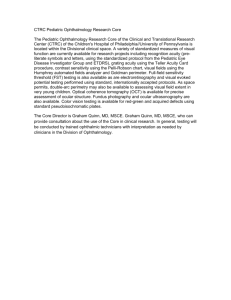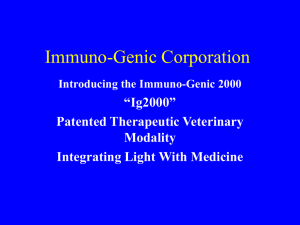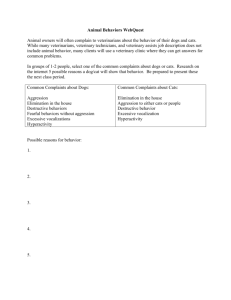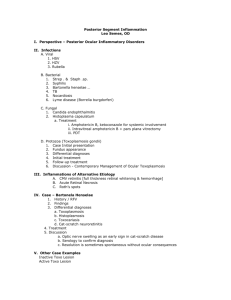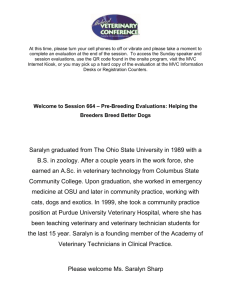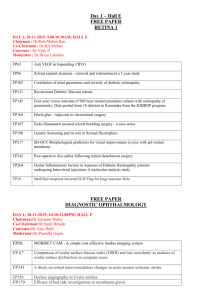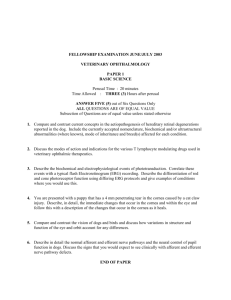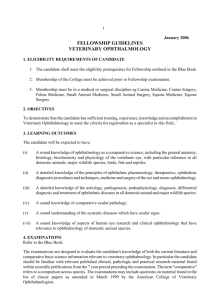VOR Checklist
advertisement
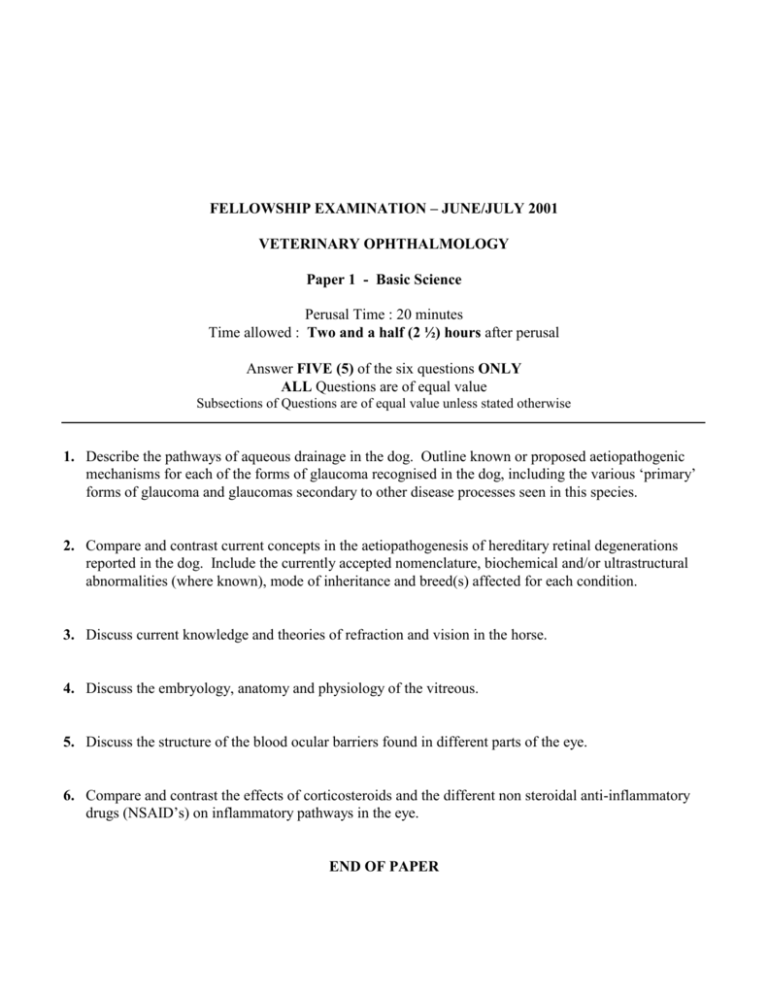
FELLOWSHIP EXAMINATION – JUNE/JULY 2001 VETERINARY OPHTHALMOLOGY Paper 1 - Basic Science Perusal Time : 20 minutes Time allowed : Two and a half (2 ½) hours after perusal Answer FIVE (5) of the six questions ONLY ALL Questions are of equal value Subsections of Questions are of equal value unless stated otherwise 1. Describe the pathways of aqueous drainage in the dog. Outline known or proposed aetiopathogenic mechanisms for each of the forms of glaucoma recognised in the dog, including the various ‘primary’ forms of glaucoma and glaucomas secondary to other disease processes seen in this species. 2. Compare and contrast current concepts in the aetiopathogenesis of hereditary retinal degenerations reported in the dog. Include the currently accepted nomenclature, biochemical and/or ultrastructural abnormalities (where known), mode of inheritance and breed(s) affected for each condition. 3. Discuss current knowledge and theories of refraction and vision in the horse. 4. Discuss the embryology, anatomy and physiology of the vitreous. 5. Discuss the structure of the blood ocular barriers found in different parts of the eye. 6. Compare and contrast the effects of corticosteroids and the different non steroidal anti-inflammatory drugs (NSAID’s) on inflammatory pathways in the eye. END OF PAPER FELLOWSHIP EXAMINATION – JUNE/JULY 2001 VETERINARY OPHTHALMOLOGY Paper 2 Part I - Applied Perusal Time : 20 minutes Time allowed : Two and a half (2½) hours after perusal Answer FIVE (5) of the six questions ONLY ALL Questions are of equal value Subsections of Questions are of equal value unless stated otherwise 1. Describe your approach to the diagnosis of amaurosis in the dog, cat and horse, including a brief description of the differential diagnoses that need to be considered for this problem in each of these species. 2. Describe the autogeneic, allogeneic and xenogeneic corneal grafting techniques used in domestic mammals, commenting on the specific indications, contraindications, advantages and disadvantages for each technique. 3. Discuss the indications, contraindications and potential complications for the forms of radiotherapy used in the treatment of ocular disease in domestic species, including brachytherapy and teletherapy techniques. 4. Discuss the current knowledge with regard to the pathophysiology and treatment of chronic superficial corneal ulcers (Indolent ulcer, Boxer ulcer) in the dog. 5. Discuss the ocular manifestations, diagnosis and treatment of Toxoplasma gondii infection in the cat. 6. Discuss the epidemiology, aetiology and pathophysiology of bovine keratoconjunctivitis. END OF PAPER FELLOWSHIP EXAMINATION – JUNE/JULY 2001 VETERINARY OPHTHALMOLOGY Paper 2 Part II - Comparative Perusal Time : 20 minutes Time allowed : Two and a half (2½) hours after perusal Answer ALL FORTY (40) Questions ALL Questions are of equal value Subsections of Questions are of equal value unless stated otherwise 1. With respect to electroretinography, which retinal layer(s) is the origin of: a. the a wave b. the b wave c. the c wave d. oscillatory potentials 2. List four lesions involving the eye or ocular adnexa associated with lymphosarcoma in horses. 3. In the Australian Shepherd Dog: a. failure of normal development of what ocular embryonic structure on day 30 of gestation has been associated with the development of posterior segment colobomas? b. individuals affected by posterior segment coloboma are homozygous for what coat colour gene? 4. List the major abnormality(s) associated with each of the six grades of severity for persistent hyperplastic tunica vasculosa lentis / persistent hyperplastic primary vitreous in the Doberman, as initially reported by Stades in 1980. 5. In rabbits name: a. the conjunctival condition in rabbits featuring an aberrant fold of conjunctival tissue arising from the limbus. b. the micro-organism associated with lens capsule rupture and phacoclastic uveitis. 6. List four ocular conditions which have been associated with feline herpes virus 1 infection in cats. Continued over/Veterinary Ophthalmology Paper 2, Part II, 2001 Continued/Veterinary Ophthalmology Paper2, Part 11, 2001 7. In Beagles with primary open angle glaucoma: a. what is the mode of inheritance? b. what group of extracellular proteoglycan components in the trabecular meshwork and juxtacanalicular zone show alterations in their amount, type and localisation? 8. What strength (dioptres) intraocular lens implant best approximates emmetropia after lens extraction in: a. dogs? b. cats? 9. Were survival rates of cats with eyes enucleated for diffuse iris melanoma higher, lower or similar to controls with eyes enucleated for other non-neoplastic diseases when: a. diffuse iris melanoma is confined to the iris and trabecular meshwork? b. diffuse iris melanoma has invaded ciliary body and/or sclera? 10. List four pathways of monosaccharide sugar metabolism in the lens. 11. In a retrospective study of 200 dogs with diabetes mellitus, what percentage (choose from 0%, 25%, 50%, 65%, 75%, 80%, 100%) of dogs was found to have developed cataracts within: a. 60 days of diagnosis of diabetes b. 170 days of diagnosis of diabetes c. 370 days of diagnosis of diabetes d. 470 days of diagnosis of diabetes 12. List four congenital ocular anomalies reported in Rocky Mountain Horses. 13. At what day post-fertilisation (choose from 25, 32, 40, 45) do the following developmental events occur in the canine eye? a. rudimentary rods and cones appear b. hyaloid artery enters through optic fissure c. eyelids fuse d. extraocular muscles become visible 14. Were survival rates of dogs with eyes enucleated for primary intraocular melanocytic neoplasia higher, lower or similar compared to age-matched controls for: a. benign melanocytomas ? b. malignant melanomas ? Continued over/Veterinary Ophthalmology Paper 2, Part II, 2001 Continued/Veterinary Ophthalmology Paper2, Part 11, 2001 15. List four ocular and/or periocular manifestations of leishmaniasis in dogs. 16. In a UK survey of Flat-coated Retriever iridocorneal angles, what was the: a. approximate heritability (choose from 0, 0.3, 0.5, 0.7) of pectinate ligament dysplasia? b. approximate predicted probability (choose from 0, 0.3, 0.5, 0.7) of glaucoma developing in animals where 75% or greater of the iridocorneal angle circumference was affected by pectinate ligament dysplasia? 17. List four fungal genera commonly isolated from corneas of horses with keratomycosis. 18. With respect to mean palpebral fissure length, which of the four values 27.8 2.7mm, 32.7 4.2mm, 34.6 3.1mm and 39.0 3.9mm applies to: a. all dogs b. dogs with entropion c. dogs with lack of contact between lid margins and globe d. all cats 19. List non-viral micro-organisms which have been associated with uveitis in cats. 20. With respect to mean limbus to ora ciliaris retinae distance in normal dog eyes, which of the four values 5.30 0.77mm, 7.18 0.89mm, 9.25 0.81mm and 9.41 0.79mm applies to: a. dorsal quadrant b. lateral quadrant c. ventral quadrant d. medial quadrant 21. With respect to ivermectin toxicity: a. name the breed of dog that is particularly susceptible b. list the ocular signs seen in dogs showing toxicity c. very briefly desrcibe the pathophysiology of the ocular signs 22. Briefly describe the ocular pathology of the ocular condition reported in Green Turtles. 23. In the dog, at approximately how many days postnatally has: a. the hyaloid system completely atrophied b. the retina completely differentiated and matured Continued over/Veterinary Ophthalmology Paper 2, Part II, 2001 Continued/Veterinary Ophthalmology Paper2, Part 11, 2001 24. List the orbital bones present in the horse. 25. List the extra-ocular muscles that originate from the orbital apex i.e the annulus of Zinn. 26. List the most common cause of infectious keratoconjunctivitis in the following species: a. bovine b. ovine c. porcine 27. List the parasites reported to cause ocular disease in the horse. 28. Name: a. the parasite that causes cataract in some fish species b. the only mammalian order in which a scleral cartilage is present 29. Name: a. the curariform drug that, when used topically, was reported to give the best mydriasis in Parrots and Kestrels b. the most common cause of blepharoconjunctivitis in Chelonians 30. Name one species of placental mammal with: a. a pure rod retina b. a pure cone retina 31. Briefly describe the ocular pathology seen in sheep and goats overdosed with closantel (Rafoxanide) 32. List the tear glands present in rodents. 33. With respect to intra-ocular pressure (IOP) in normal dairy cattle: a. what is the mean IOP ? b. what is the range ? 34. List four laboratory methods used to diagnose FHV-1 infections in cats and indicate which is the most sensitive. 35. Define the term Campanula of Haller. Continued over/Veterinary Ophthalmology Paper 2, Part II, 2001 Continued/Veterinary Ophthalmology Paper2, Part 11, 2001 36. Briefly describe the aetiology of strabismus as reported in white Bengal Tigers. 37. Briefly describe the difference between the nasolacrimal system of the pig compared to the majority of other domestic mammal species. 38. List four therapeutic agents that can be used to treat Feline eosinophylic keratoconjunctivitis. 39. List non-ocular signs that may also be seen in cats with taurine deficiency retinopathy. 40. Briefly describe the expected ocular manifestations of: a. hypercholesterolaemia b. hypertriglyceridaemia END OF PAPER
